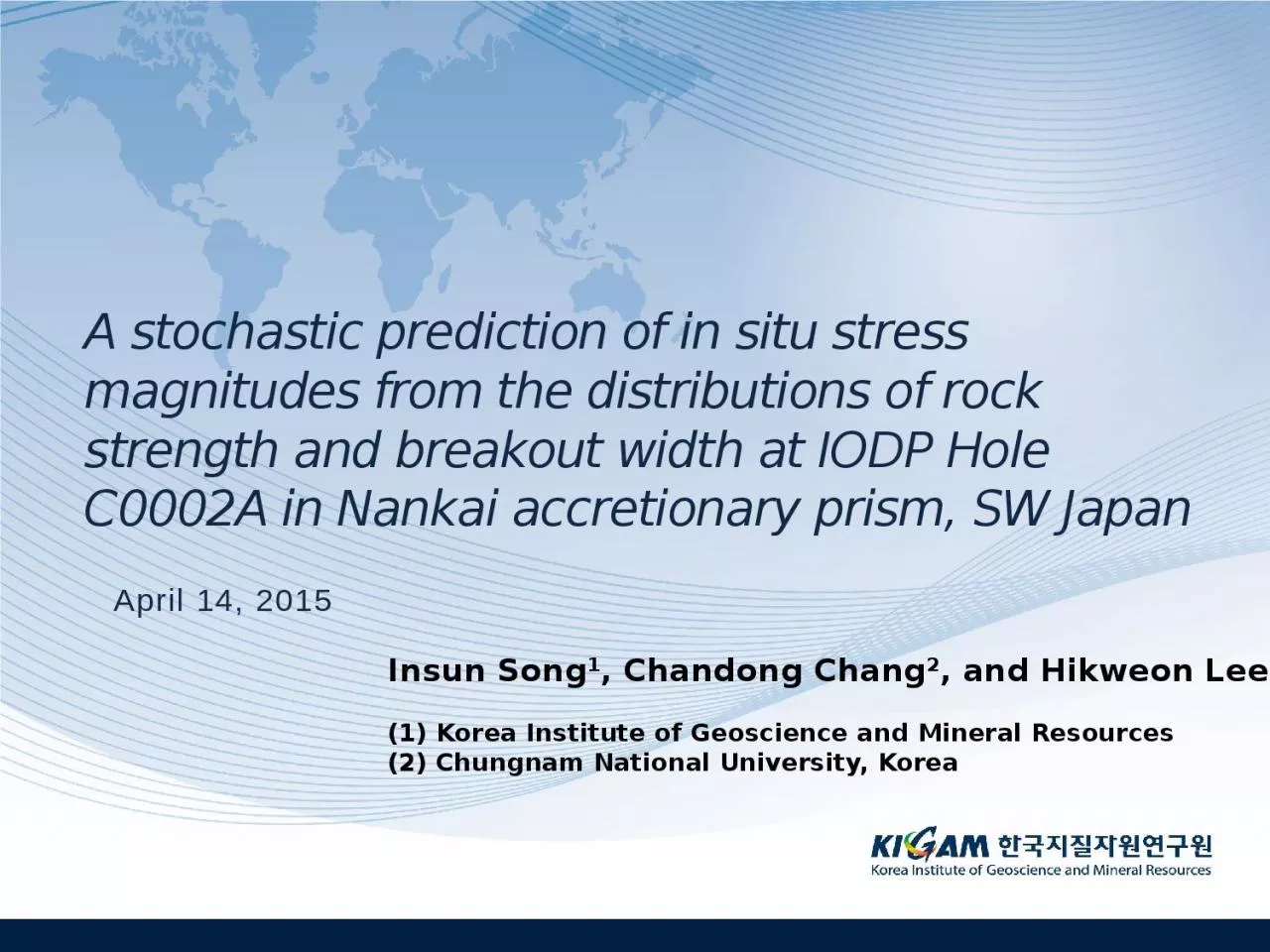

Nankai accretionary prism SW Japan April 14 2015 Insun Song 1 Chandong Chang 2 and Hikweon Lee 1 1 Korea Institute of Geoscience and Mineral Resources 2 Chungnam ID: 1021041
Download Presentation The PPT/PDF document "A stochastic prediction of in situ stres..." is the property of its rightful owner. Permission is granted to download and print the materials on this web site for personal, non-commercial use only, and to display it on your personal computer provided you do not modify the materials and that you retain all copyright notices contained in the materials. By downloading content from our website, you accept the terms of this agreement.
1. A stochastic prediction of in situ stress magnitudes from the distributions of rock strength and breakout width at IODP Hole C0002A in Nankai accretionary prism, SW JapanApril 14, 2015Insun Song1, Chandong Chang2, and Hikweon Lee1(1) Korea Institute of Geoscience and Mineral Resources(2) Chungnam National University, Korea
2. Location of study area and tectonic setting
3. Geologic profile
4. Breakouts and in situ stressshminshminshmaxshmaxIODP EXP 314 NanTroSEIZE report051015060120180240300360sqq (MPa)q (º)sHrockstrengthbb
5. Strength vs. sonic velocityDepth (mbsf)VP (m/s)UCS (MPa)CountsVP (m/s)C0002A 200-230 mbsfAve.=1784.4m/s(Chang et al., 2009)
6. 1.52.03.54.0060120180240300360sqq (MPa)q (º)sHbBHeight (m)BC0002A (200-230mbsf)CountsUCS (MPa)C0002A 200-230 mbsfDetermination of far-field stress magnitudes bhmaxbreakoutB
7. Average strength vs. average breakout widthStress (MPa)q (o)Average strengthAverage width
8. Strength distribution vs. breakout width distribution Stress (MPa)q (o)
9. In situ stress determination algorithmCountsUCS (MPa)For Sh = 26 MPaDSH = 0.05 MPaIntegration of all misfitsSH = 28.5 MPaBFor Sh = 26 MPaDSH = 0.05 MPaCumulated density in height (m)Cumulated probabilityAssume Gaussian distribution of UCS(P) and mi = 0.6 (Song et al., 2010)Using the M-C failure criterion with probability, calculate the probability function of breakout width for given far-field stresses (Shmax and Shmin)Compare the probability with breakout density in heightSelect the far-field stress with the minimum misfit
10. Examples of grid searching method335 mbsf484 mbsf1295 mbsf1172 mbsf845 mbsfShmin from LOT875 mbsf
11. Stress profilesms=0.6hydrostaticLithostatic(Chang et al., 2009)unconformityLOP
12. Stress polygonC0002ALOP
13. ConclusionsUsing the distributions of rock strength and breakout width instead of their averages, we were able to determine both Shmin and SHmax simultaneously.In normal faulting stress regime, Shmin is insensitive to error and becomes more sensitive as it goes to the strike-slip faulting stress regime.In Kumano forearc basin in situ stress is very close to the limit equilibrium condition for normal faulting.Underneath the unconformity the stress condition becomes stable and goes to the strike-slip fault stress regime with increasing depth.
14. THANK YOU